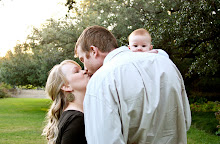There are many reasons that I am thankful I have become a "birth junkie" before having children of my own. Many doulas happen upon this as their calling because they had a wonderful or not so wonderful previous birth experience. But, for me, I desire to educate, care for, and nourish pregnant and birthing mothers.
The "cut" is one of those things I dread to see and hear happen in births. It looks awful and sounds horrid when it is happening. Flesh being cut with scissors is almost the worst sound ever next to nails on a chalkboard!
If dads could really grasp what the "cut" is and all it entails, I believe he would demand for it not to happen at all costs. The first time I educated my husband about it, he was mortified and cringed in horror. I knew at that point that when the time came, he would fight for me if it comes to that.
When I discuss a birthing with my hospital clients and the "cut" comes up, I am sure to let them know that they need to discuss that with their caregiver and the nurses they have in the hospital. Many nurses will help adequately prepare the perineum for the birth. I also discuss the benefits of kegel exercises that help to prepare and strengthen the pelvic floor.
Many midwives pride themselves in having minimal perineal tearing in births. They will use hot compresses and perineal massage with oils. Midwives do not perform episiotomies and most believe that tearing, if that occurs, will heal better.
What is an episiotomy?An
episiotomy is a cut made in the back of the vagina to enlarge it for birth. With
midline or
median episiotomy, (the type usual in the U.S. and Canada), the cut is made from the back of the vaginal opening straight toward the anus. With
mediolateral episiotomy (the usual type in most of the rest of the world), the cut is made off to one side. See photos below.

 How does an episiotomy affect my pelvic floor?
How does an episiotomy affect my pelvic floor?In the past, most care providers believed that
episiotomy would prevent serious tears extending into the anal muscle. Anal muscle injury is a concern as it can lead to leaking gas, a sense of urgency about elimination, or even leaking feces (
bowel incontinence).
However, a large body of consistent research has shown that liberal or routine use of
episiotomy promotes rather than prevents
pelvic floor dysfunction. It offers no advantages over the spontaneous tissue tears that may occur during birth.
Midline episiotomy (the type that is usual in the U.S. and Canada) increases risk for tears into or through the anal muscle. Nearly all anal muscle tears that occur during birth are extensions of
midline episiotomies.
Mediolateral episiotomy (the cut is made diagonally off to one side) is usual in most other parts of the world. Although it doesn't seem to cause anal muscle tears, it doesn't prevent them either. Women with no
episiotomy have similar low risk for anal muscle tears compared with women with
mediolateral episiotomy. This type of incision, however, goes through muscle fibers and can involve a longer, more painful healing period, scarring, and sometimes a scar with uneven healing that pulls to one side.
What is a reasonable episiotomy rate?While the percentage of women who give birth vaginally and have
episiotomies has fallen steadily in recent decades in the U.S., it still has far to go. Currently, about 35 in 100 women with vaginal births have episiotomies.
Episiotomy rates vary widely across caregivers and across birth settings; studies show that they could safely be much lower, 7 or fewer in every 100 vaginal births.
How can I avoid an episiotomy?With 1 woman in 3 with a vaginal birth in the U.S. having an
episiotomy and much higher rates in many other parts of the world, it is important to understand the practice style of those who might attend your birth. If possible, arrange to receive care from a caregiver (or group of caregivers) with a commitment to restricted use of this procedure. If this is not possible, make it quite clear that you do not want an episiotomy unless there is a medically urgent need to hurry the birth.
When might an episiotomy be recommended?About the only reason most caregivers would agree that an
episiotomy is appropriate is when the baby is close to being born and an urgent problem develops.
When examined in scientific studies,
none of the reasons given for the common or routine use of
episiotomy holds up, including:
- Woman is a first-time mother: Studies that attempt to restrict episiotomy do not find that having a first baby is in and of itself a reason for episiotomy.
- Caregiver believes a tear is about to occur: Performing an episiotomy for this reason has not been shown to have a protective effect.
- Woman is having a vacuum extraction or forceps delivery: Women are much less likely to have anal muscle injuries if they don't have a midline episiotomy with an assisted vaginal birth. (Mediolateral episiotomy neither prevents nor causes anal injury compared with no episiotomy.)
- Belief that episiotomy prevents pelvic floor weakness: Women are just as likely to have weak pelvic floors or urinary incontinence in the early months after childbirth with or without an episiotomy. Women with no episiotomy and no or only a tiny tear at birth (intact perineum) have the strongest pelvic floors while women with tears into the anal muscle have the weakest pelvic floors. Women with spontaneous tears do just as well as, or better than, women with episiotomies.
- Belief that episiotomy is easier to repair (to stitch closed) than a tear: No research supports this claim. Certainly the tear that occurs when a midline episiotomy extends into the anal muscle is more difficult to repair than more a small tear. With optimal care, many women will need no more than a few stitches or no stitches at all.
- Belief that episiotomy heals better: An episiotomy of either type is more likely to have delayed healing or to become infected in comparison with no episiotomy. A mediolateral episiotomy is more likely to scar and heal pulled to one side compared with the tears that may occur with no episiotomy.
Take the poll located on the right of the blog.













